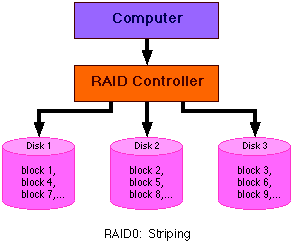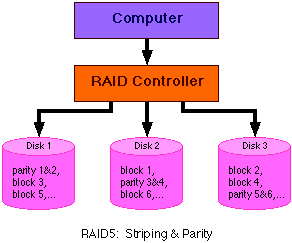
RAID-0
Level 0 is not redundant, hence does not truly fit the "R.A.I.D."
acronym. In level 0, information is split across drives, resulting in
higher data throughput. Since no redundant information is stored,
performance is very good, but the failure of any disk in the array
results in information loss. This level is commonly referred to as
striping.

RAID-1
Level 1 provides redundancy by writing all information to two or more
drives. The performance of a level 1 array tends to be faster on reads
and slower on writes compared to a single drive, but if either drive
fails, no information is lost. This is a good entry-level redundant
system, since only two drives are required; however, since one drive is
used to store a duplicate of the other, the cost per megabyte is high.
This level is commonly referred to as mirroring.

RAID-5
Level 5 employs a combination of striping and parity checking. The use
of parity checking provides redundancy without the overhead of having
to double disk capacity. Simply put, parity checking involves
determining whether each given block has an odd or even value. These
values are summed across the stripe sets to obtain a parity value. With
this parity value, the contents of a failed drive can easily be
determined and rebuilt on a spare drive.






